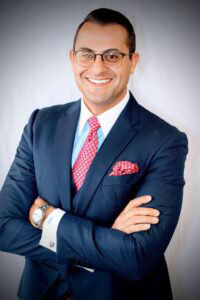Hassan named president of the neurologist society
Nov 30, 2022HARLINGEN – Mechanical thrombectomy.
The name sounds scary, but this revolutionary new technique is saving lives by removing blood clots from arteries.

Dr. Ameer Hassan, head of the neuroscience department at Valley Baptist Medical Center, has been hailing its use not only to save lives but to improve outcomes. In other words, with this new technique, patients can have better recovery with few complications.
Perhaps that’s why he’s so active in The Society of Vascular Interventional Neurology and was recently named president of the organization.
“It’s a society of all interventional neurologists in the U.S. and the world and it’s by far the biggest society for interventional neurologists,” Hassan said. “The big thing here is that we’re trying to take it to the next level. We are trying to improve access to mechanical thrombectomy worldwide.”
The society has undertaken numerous initiatives toward that purpose, one of them being the Mission Thrombectomy 2020 campaign. The website missionthrombectomy2020.org says SVIN founded the campaign in 2016.
The goal of the campaign was to increase the rate of stroke thrombectomy procedures to 202,000 a year to reduce stroke disability around the world by 2020. Stroke thrombectomy is the same as mechanical thrombectomy.
The project met its goal. Hassan said that by 2020 the number of mechanical thrombectomies had doubled around the world.
Hassan began serving as president elect of SVIN two years ago and finally took over as president in November. That’s about the time the Society began doing thrombectomy workshops in places near and far.
“We just did a workshop in Jamaica which was a huge success,” he said. “We have one scheduled in the Dominican Republic in May. We are working with the Turkish Society to also help them improve access to interventionalists who can treat stroke with mechanical thrombectomy throughout their country. We have programs going on in India and China, so really the footprint is growing rapidly.”
Hassan further described with great pride SVIN’s educational initiatives in the form of grants to students, residents and fellows wishing to do endovascular research.
“We also created an educational course called Advanced Stroke Emergency Support – ASES – and we created a specific course for ED and another course for EMS,” he said.
ED stands for Emergency Department and EMS stands for Emergency Medical Services.
“Now we will be working with EMS World which is the biggest EMS conference in the world,” he said. “We are doing a session with them and teaching them our course, our material, and we have a couple of members working with the State of Texas and other states around the country.”
SVIN’s message is that here is a great “re-educational tool.”
“We think that EMSs around the state should be certified with this course,” Hassan said. “Just like they’re certified with advanced cardiovascular life support, they should also be trained with this ASES course.”
He believed this additional training will further enhance health care professionals’ ability to spot a stroke and determine where to send a patient. In the incidence of stroke, efficiency and speed are especially critical because “time is brain.”
“We can truly improve patient outcomes by taking patients faster to the emergency room and to the right hospital,” Hassan said.
Still another initiative is called SILC – Stroke Interventional Lab Certification. The certification is intended to have a good standard of care at catheter labs across the country.
It’s clearly evident that many good things are coming out of SVIN, and Hassan is delighted to take the lead in the organization.
“Of course, I’m excited,” he said. “I’ve been working with the society and the board for more than six years, so it’s great to see that people recognize that I would be a great asset to the society and be able to extend and expand its mission. I’m the first president who is not one of the original founders.”

